Report on IT Management Issues: Monet Group of Resorts
VerifiedAdded on 2020/03/16
|10
|1718
|37
Report
AI Summary
This report analyzes the IT management issues faced by the Monet Group, a collection of five holiday resorts, exploring their business decisions and strategic implementations. The report focuses on several key decisions made by the senior management, including the introduction of a customer loyalty scheme (Monet Loyalty), the development of interactive tools to enhance customer tour selection, the implementation of a new Enterprise Resource Planning (ERP) system for integrated business functions, and the adoption of a Web 4.0 level intelligent electronic portal to facilitate customer self-management. The report critiques each decision, providing insights into their potential benefits and drawbacks, and offers recommendations for the Monet Group to navigate challenges and optimize their business strategies. The analysis considers factors such as customer satisfaction, technological integration, and the overall impact on the business's profitability and operational efficiency.
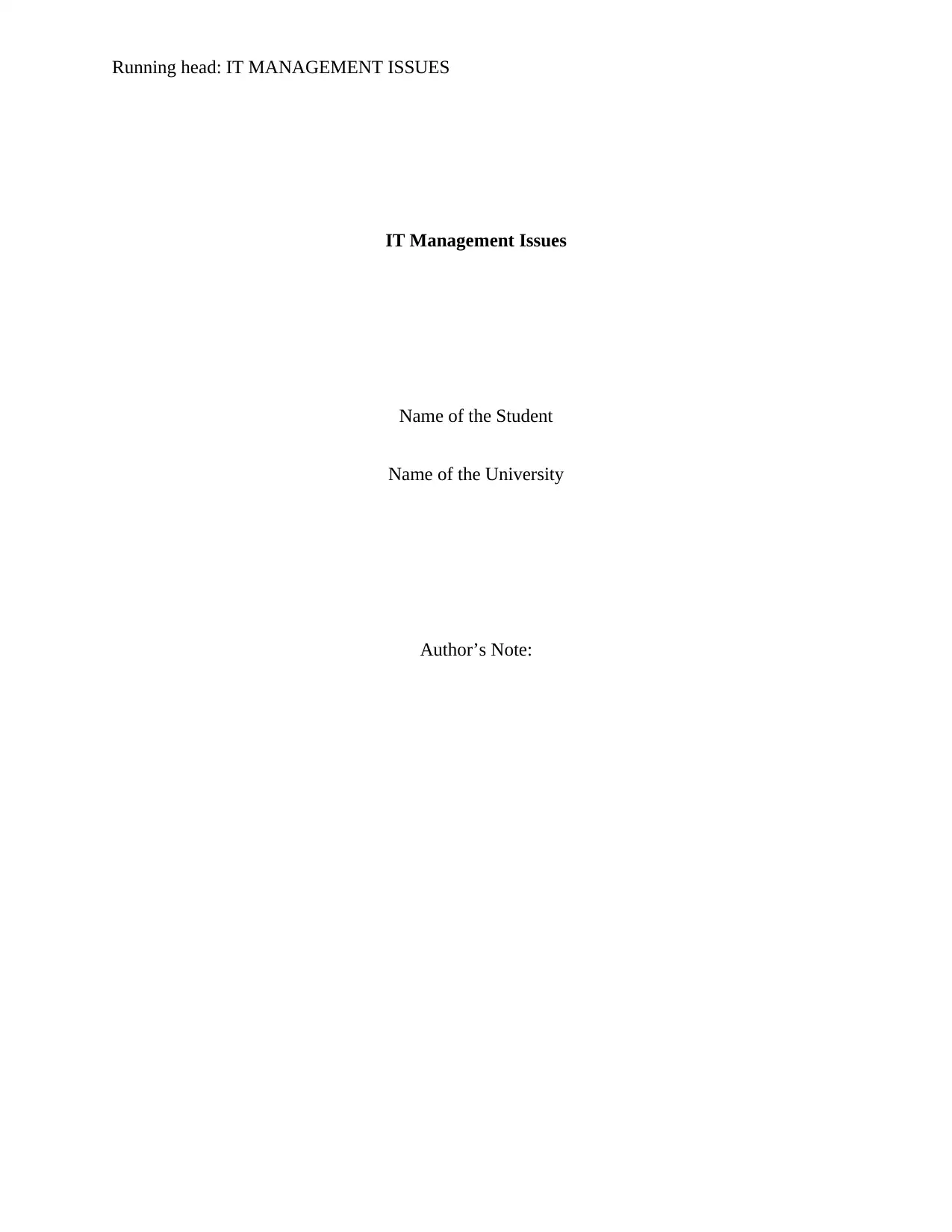
Running head: IT MANAGEMENT ISSUES
IT Management Issues
Name of the Student
Name of the University
Author’s Note:
IT Management Issues
Name of the Student
Name of the University
Author’s Note:
Paraphrase This Document
Need a fresh take? Get an instant paraphrase of this document with our AI Paraphraser
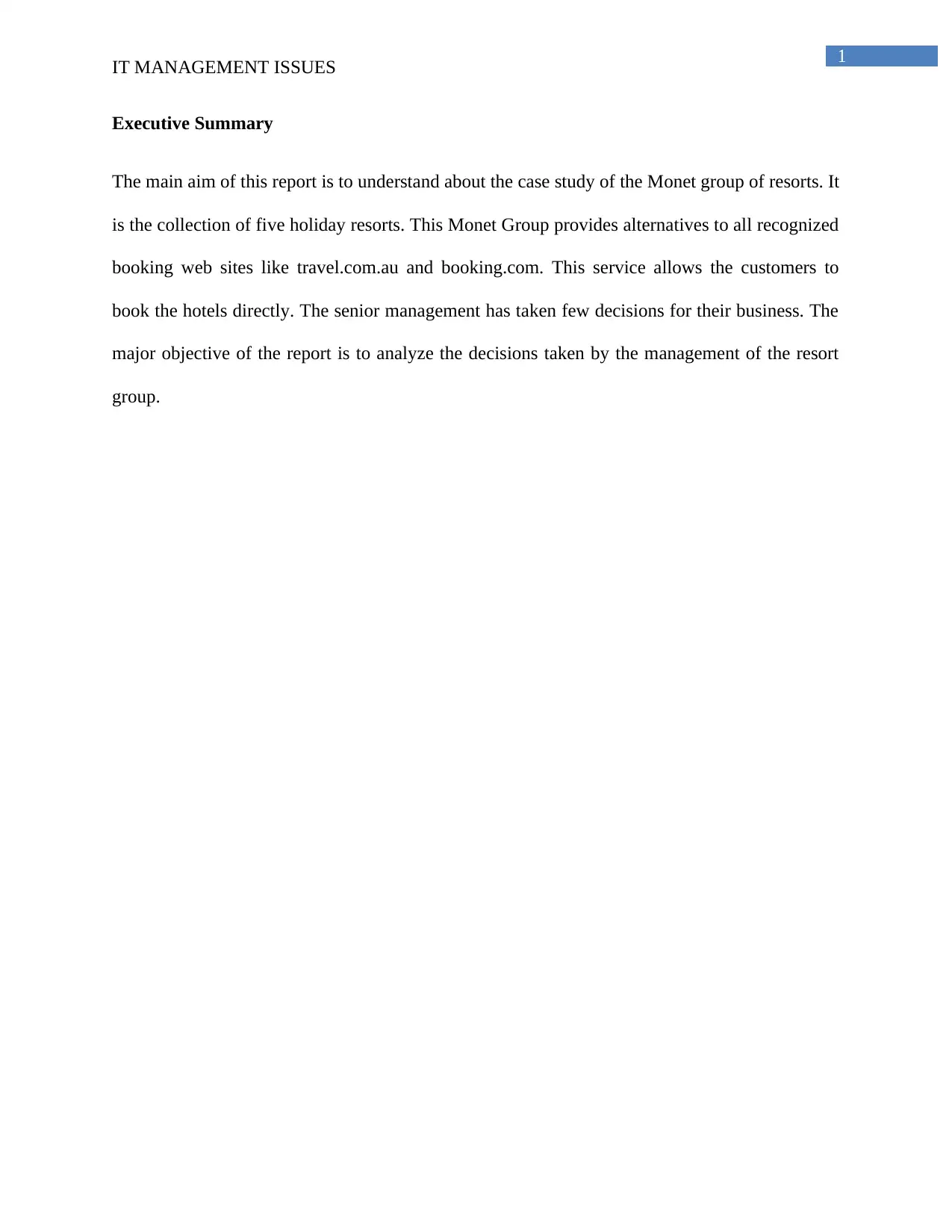
1
IT MANAGEMENT ISSUES
Executive Summary
The main aim of this report is to understand about the case study of the Monet group of resorts. It
is the collection of five holiday resorts. This Monet Group provides alternatives to all recognized
booking web sites like travel.com.au and booking.com. This service allows the customers to
book the hotels directly. The senior management has taken few decisions for their business. The
major objective of the report is to analyze the decisions taken by the management of the resort
group.
IT MANAGEMENT ISSUES
Executive Summary
The main aim of this report is to understand about the case study of the Monet group of resorts. It
is the collection of five holiday resorts. This Monet Group provides alternatives to all recognized
booking web sites like travel.com.au and booking.com. This service allows the customers to
book the hotels directly. The senior management has taken few decisions for their business. The
major objective of the report is to analyze the decisions taken by the management of the resort
group.
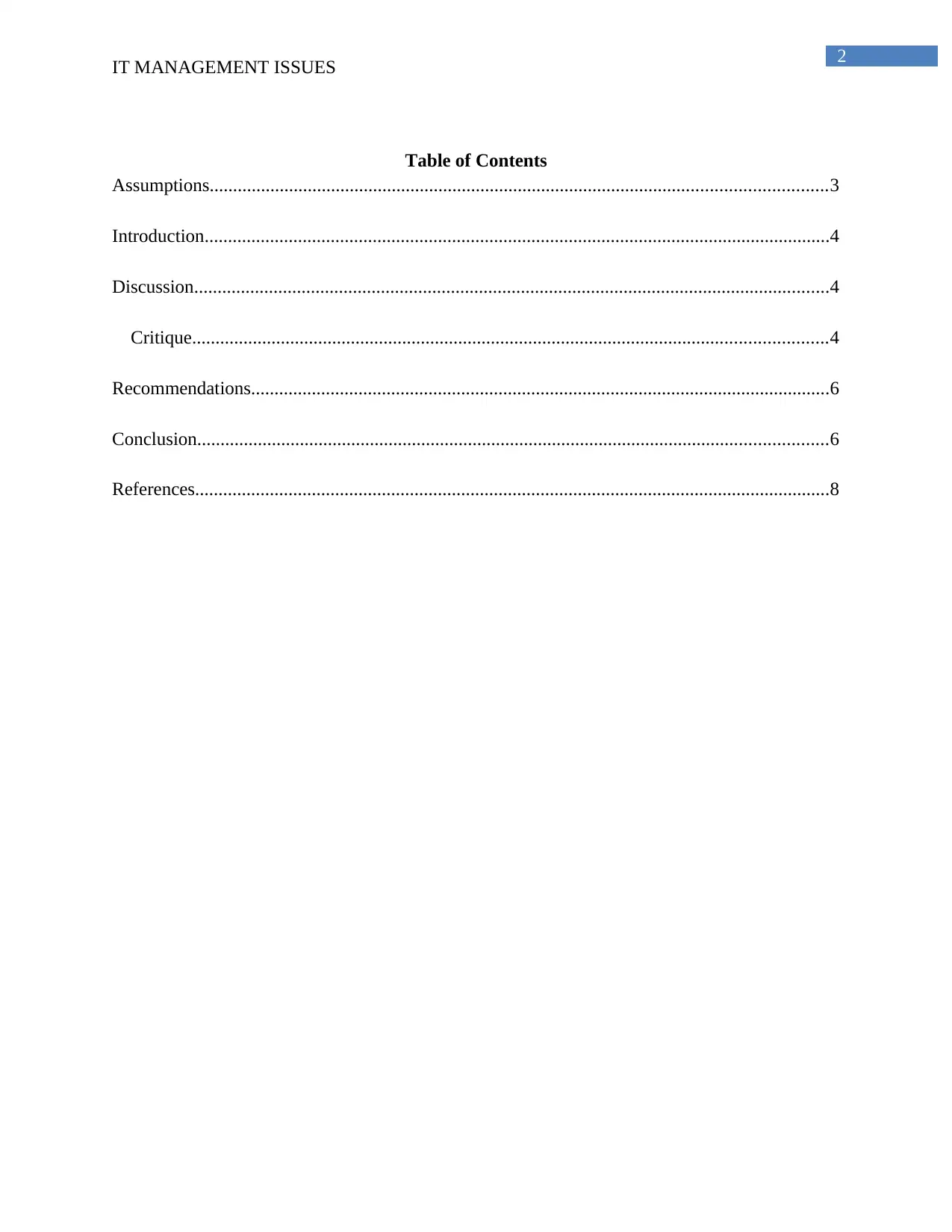
2
IT MANAGEMENT ISSUES
Table of Contents
Assumptions....................................................................................................................................3
Introduction......................................................................................................................................4
Discussion........................................................................................................................................4
Critique........................................................................................................................................4
Recommendations............................................................................................................................6
Conclusion.......................................................................................................................................6
References........................................................................................................................................8
IT MANAGEMENT ISSUES
Table of Contents
Assumptions....................................................................................................................................3
Introduction......................................................................................................................................4
Discussion........................................................................................................................................4
Critique........................................................................................................................................4
Recommendations............................................................................................................................6
Conclusion.......................................................................................................................................6
References........................................................................................................................................8
⊘ This is a preview!⊘
Do you want full access?
Subscribe today to unlock all pages.

Trusted by 1+ million students worldwide
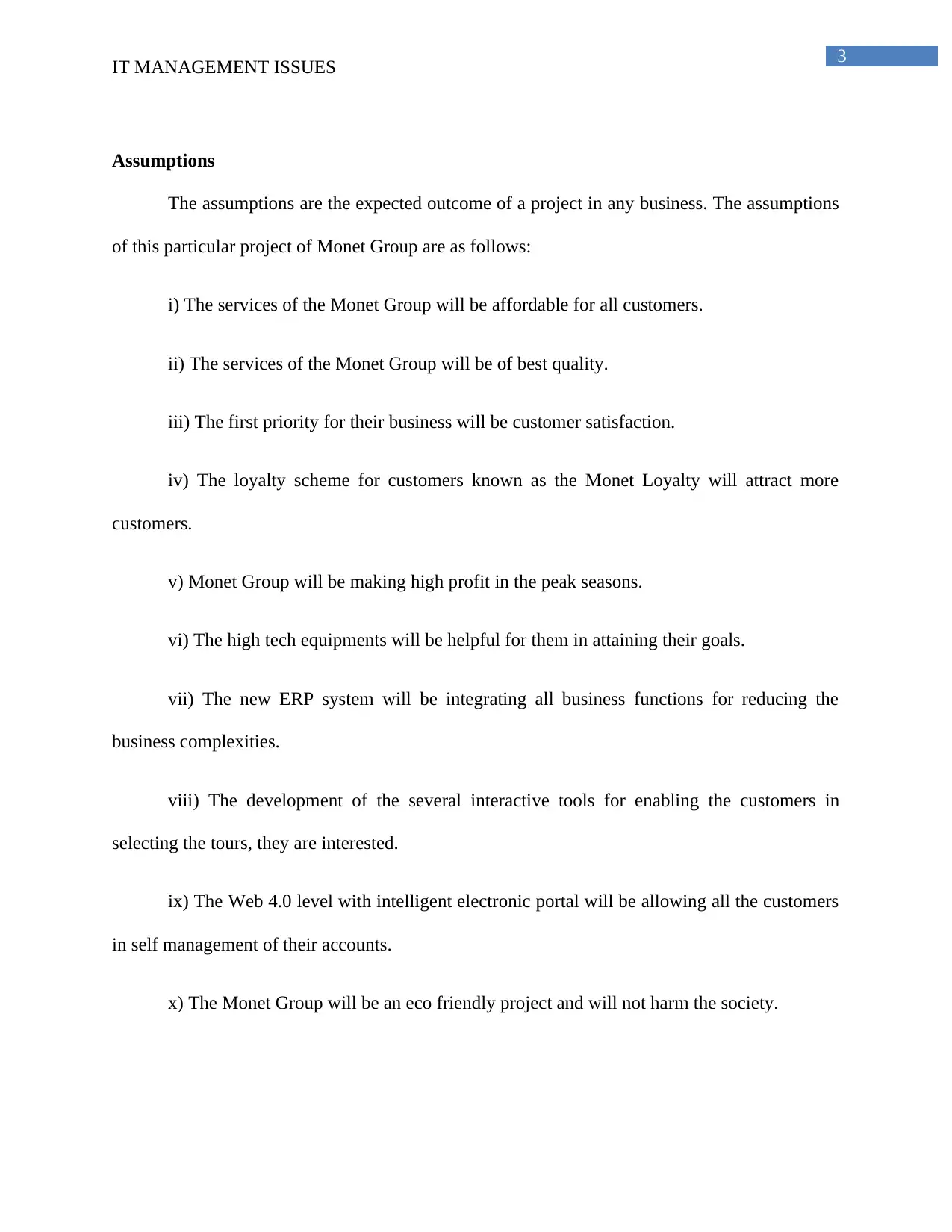
3
IT MANAGEMENT ISSUES
Assumptions
The assumptions are the expected outcome of a project in any business. The assumptions
of this particular project of Monet Group are as follows:
i) The services of the Monet Group will be affordable for all customers.
ii) The services of the Monet Group will be of best quality.
iii) The first priority for their business will be customer satisfaction.
iv) The loyalty scheme for customers known as the Monet Loyalty will attract more
customers.
v) Monet Group will be making high profit in the peak seasons.
vi) The high tech equipments will be helpful for them in attaining their goals.
vii) The new ERP system will be integrating all business functions for reducing the
business complexities.
viii) The development of the several interactive tools for enabling the customers in
selecting the tours, they are interested.
ix) The Web 4.0 level with intelligent electronic portal will be allowing all the customers
in self management of their accounts.
x) The Monet Group will be an eco friendly project and will not harm the society.
IT MANAGEMENT ISSUES
Assumptions
The assumptions are the expected outcome of a project in any business. The assumptions
of this particular project of Monet Group are as follows:
i) The services of the Monet Group will be affordable for all customers.
ii) The services of the Monet Group will be of best quality.
iii) The first priority for their business will be customer satisfaction.
iv) The loyalty scheme for customers known as the Monet Loyalty will attract more
customers.
v) Monet Group will be making high profit in the peak seasons.
vi) The high tech equipments will be helpful for them in attaining their goals.
vii) The new ERP system will be integrating all business functions for reducing the
business complexities.
viii) The development of the several interactive tools for enabling the customers in
selecting the tours, they are interested.
ix) The Web 4.0 level with intelligent electronic portal will be allowing all the customers
in self management of their accounts.
x) The Monet Group will be an eco friendly project and will not harm the society.
Paraphrase This Document
Need a fresh take? Get an instant paraphrase of this document with our AI Paraphraser
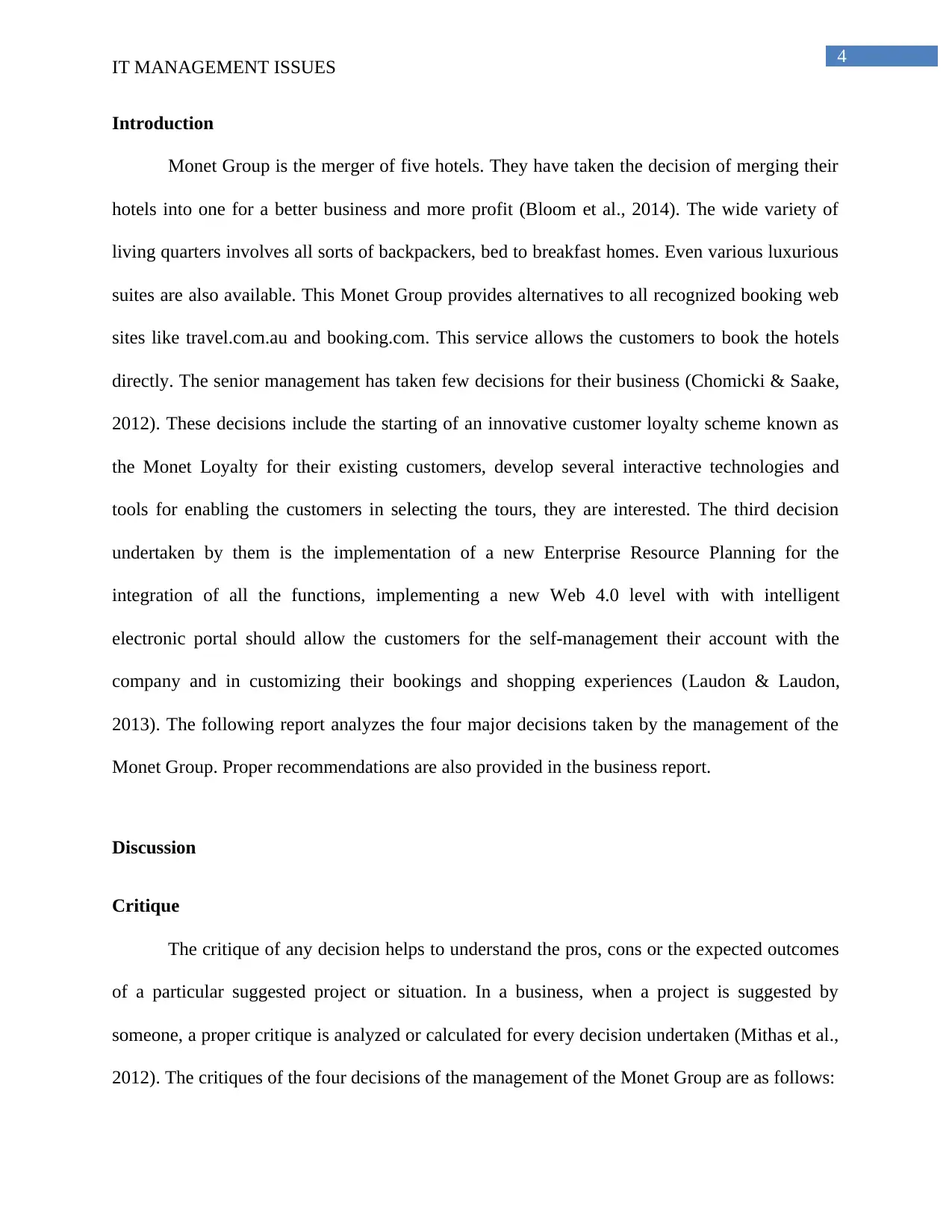
4
IT MANAGEMENT ISSUES
Introduction
Monet Group is the merger of five hotels. They have taken the decision of merging their
hotels into one for a better business and more profit (Bloom et al., 2014). The wide variety of
living quarters involves all sorts of backpackers, bed to breakfast homes. Even various luxurious
suites are also available. This Monet Group provides alternatives to all recognized booking web
sites like travel.com.au and booking.com. This service allows the customers to book the hotels
directly. The senior management has taken few decisions for their business (Chomicki & Saake,
2012). These decisions include the starting of an innovative customer loyalty scheme known as
the Monet Loyalty for their existing customers, develop several interactive technologies and
tools for enabling the customers in selecting the tours, they are interested. The third decision
undertaken by them is the implementation of a new Enterprise Resource Planning for the
integration of all the functions, implementing a new Web 4.0 level with with intelligent
electronic portal should allow the customers for the self-management their account with the
company and in customizing their bookings and shopping experiences (Laudon & Laudon,
2013). The following report analyzes the four major decisions taken by the management of the
Monet Group. Proper recommendations are also provided in the business report.
Discussion
Critique
The critique of any decision helps to understand the pros, cons or the expected outcomes
of a particular suggested project or situation. In a business, when a project is suggested by
someone, a proper critique is analyzed or calculated for every decision undertaken (Mithas et al.,
2012). The critiques of the four decisions of the management of the Monet Group are as follows:
IT MANAGEMENT ISSUES
Introduction
Monet Group is the merger of five hotels. They have taken the decision of merging their
hotels into one for a better business and more profit (Bloom et al., 2014). The wide variety of
living quarters involves all sorts of backpackers, bed to breakfast homes. Even various luxurious
suites are also available. This Monet Group provides alternatives to all recognized booking web
sites like travel.com.au and booking.com. This service allows the customers to book the hotels
directly. The senior management has taken few decisions for their business (Chomicki & Saake,
2012). These decisions include the starting of an innovative customer loyalty scheme known as
the Monet Loyalty for their existing customers, develop several interactive technologies and
tools for enabling the customers in selecting the tours, they are interested. The third decision
undertaken by them is the implementation of a new Enterprise Resource Planning for the
integration of all the functions, implementing a new Web 4.0 level with with intelligent
electronic portal should allow the customers for the self-management their account with the
company and in customizing their bookings and shopping experiences (Laudon & Laudon,
2013). The following report analyzes the four major decisions taken by the management of the
Monet Group. Proper recommendations are also provided in the business report.
Discussion
Critique
The critique of any decision helps to understand the pros, cons or the expected outcomes
of a particular suggested project or situation. In a business, when a project is suggested by
someone, a proper critique is analyzed or calculated for every decision undertaken (Mithas et al.,
2012). The critiques of the four decisions of the management of the Monet Group are as follows:
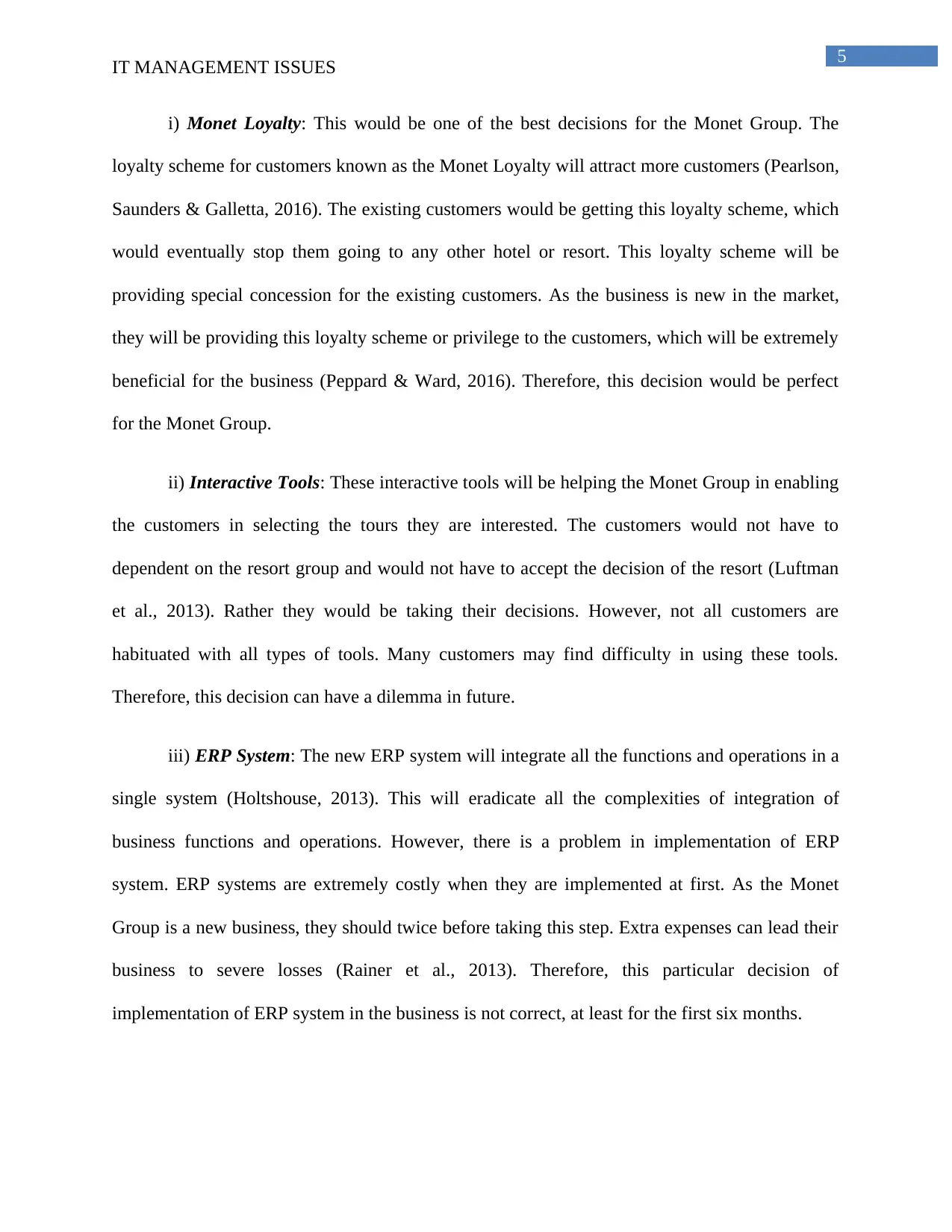
5
IT MANAGEMENT ISSUES
i) Monet Loyalty: This would be one of the best decisions for the Monet Group. The
loyalty scheme for customers known as the Monet Loyalty will attract more customers (Pearlson,
Saunders & Galletta, 2016). The existing customers would be getting this loyalty scheme, which
would eventually stop them going to any other hotel or resort. This loyalty scheme will be
providing special concession for the existing customers. As the business is new in the market,
they will be providing this loyalty scheme or privilege to the customers, which will be extremely
beneficial for the business (Peppard & Ward, 2016). Therefore, this decision would be perfect
for the Monet Group.
ii) Interactive Tools: These interactive tools will be helping the Monet Group in enabling
the customers in selecting the tours they are interested. The customers would not have to
dependent on the resort group and would not have to accept the decision of the resort (Luftman
et al., 2013). Rather they would be taking their decisions. However, not all customers are
habituated with all types of tools. Many customers may find difficulty in using these tools.
Therefore, this decision can have a dilemma in future.
iii) ERP System: The new ERP system will integrate all the functions and operations in a
single system (Holtshouse, 2013). This will eradicate all the complexities of integration of
business functions and operations. However, there is a problem in implementation of ERP
system. ERP systems are extremely costly when they are implemented at first. As the Monet
Group is a new business, they should twice before taking this step. Extra expenses can lead their
business to severe losses (Rainer et al., 2013). Therefore, this particular decision of
implementation of ERP system in the business is not correct, at least for the first six months.
IT MANAGEMENT ISSUES
i) Monet Loyalty: This would be one of the best decisions for the Monet Group. The
loyalty scheme for customers known as the Monet Loyalty will attract more customers (Pearlson,
Saunders & Galletta, 2016). The existing customers would be getting this loyalty scheme, which
would eventually stop them going to any other hotel or resort. This loyalty scheme will be
providing special concession for the existing customers. As the business is new in the market,
they will be providing this loyalty scheme or privilege to the customers, which will be extremely
beneficial for the business (Peppard & Ward, 2016). Therefore, this decision would be perfect
for the Monet Group.
ii) Interactive Tools: These interactive tools will be helping the Monet Group in enabling
the customers in selecting the tours they are interested. The customers would not have to
dependent on the resort group and would not have to accept the decision of the resort (Luftman
et al., 2013). Rather they would be taking their decisions. However, not all customers are
habituated with all types of tools. Many customers may find difficulty in using these tools.
Therefore, this decision can have a dilemma in future.
iii) ERP System: The new ERP system will integrate all the functions and operations in a
single system (Holtshouse, 2013). This will eradicate all the complexities of integration of
business functions and operations. However, there is a problem in implementation of ERP
system. ERP systems are extremely costly when they are implemented at first. As the Monet
Group is a new business, they should twice before taking this step. Extra expenses can lead their
business to severe losses (Rainer et al., 2013). Therefore, this particular decision of
implementation of ERP system in the business is not correct, at least for the first six months.
⊘ This is a preview!⊘
Do you want full access?
Subscribe today to unlock all pages.

Trusted by 1+ million students worldwide
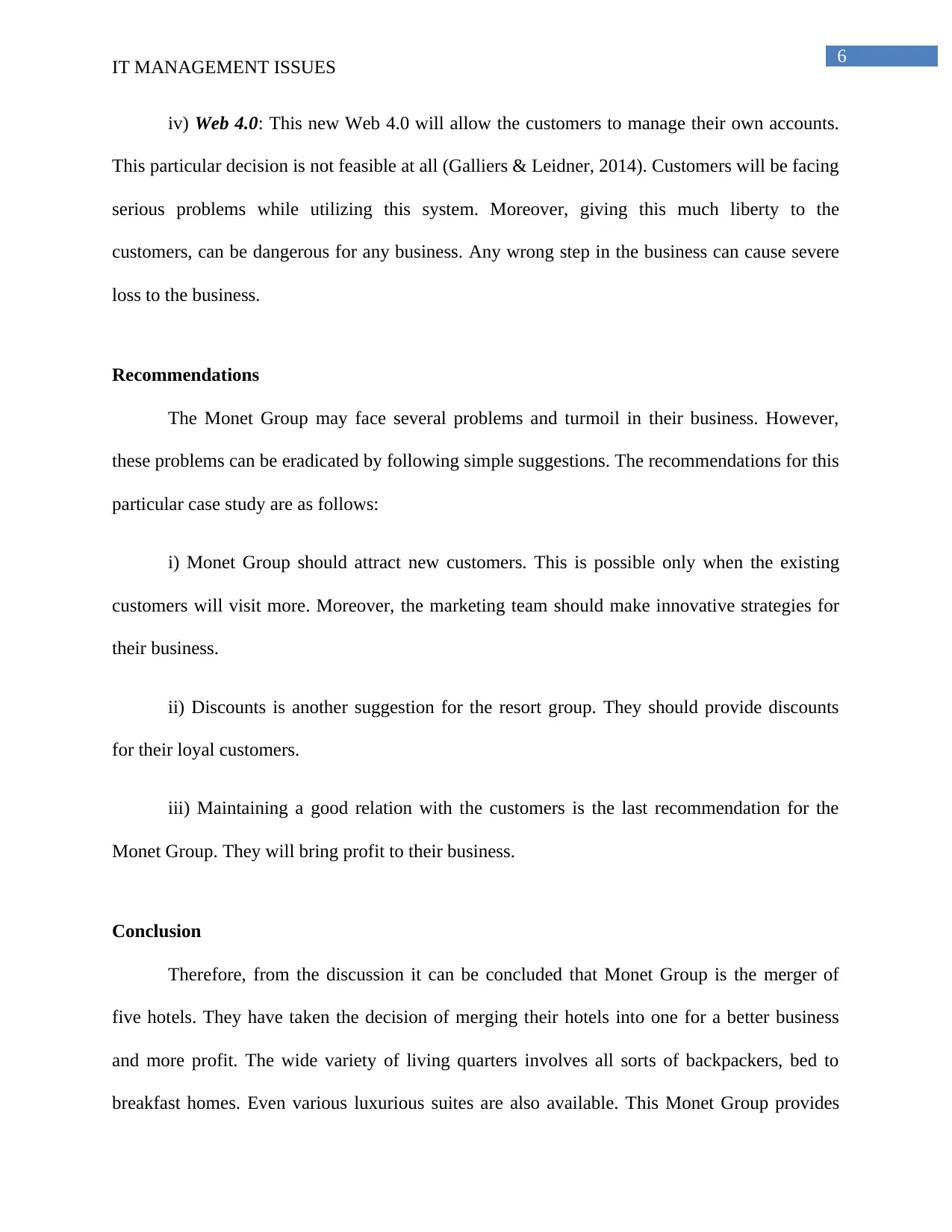
6
IT MANAGEMENT ISSUES
iv) Web 4.0: This new Web 4.0 will allow the customers to manage their own accounts.
This particular decision is not feasible at all (Galliers & Leidner, 2014). Customers will be facing
serious problems while utilizing this system. Moreover, giving this much liberty to the
customers, can be dangerous for any business. Any wrong step in the business can cause severe
loss to the business.
Recommendations
The Monet Group may face several problems and turmoil in their business. However,
these problems can be eradicated by following simple suggestions. The recommendations for this
particular case study are as follows:
i) Monet Group should attract new customers. This is possible only when the existing
customers will visit more. Moreover, the marketing team should make innovative strategies for
their business.
ii) Discounts is another suggestion for the resort group. They should provide discounts
for their loyal customers.
iii) Maintaining a good relation with the customers is the last recommendation for the
Monet Group. They will bring profit to their business.
Conclusion
Therefore, from the discussion it can be concluded that Monet Group is the merger of
five hotels. They have taken the decision of merging their hotels into one for a better business
and more profit. The wide variety of living quarters involves all sorts of backpackers, bed to
breakfast homes. Even various luxurious suites are also available. This Monet Group provides
IT MANAGEMENT ISSUES
iv) Web 4.0: This new Web 4.0 will allow the customers to manage their own accounts.
This particular decision is not feasible at all (Galliers & Leidner, 2014). Customers will be facing
serious problems while utilizing this system. Moreover, giving this much liberty to the
customers, can be dangerous for any business. Any wrong step in the business can cause severe
loss to the business.
Recommendations
The Monet Group may face several problems and turmoil in their business. However,
these problems can be eradicated by following simple suggestions. The recommendations for this
particular case study are as follows:
i) Monet Group should attract new customers. This is possible only when the existing
customers will visit more. Moreover, the marketing team should make innovative strategies for
their business.
ii) Discounts is another suggestion for the resort group. They should provide discounts
for their loyal customers.
iii) Maintaining a good relation with the customers is the last recommendation for the
Monet Group. They will bring profit to their business.
Conclusion
Therefore, from the discussion it can be concluded that Monet Group is the merger of
five hotels. They have taken the decision of merging their hotels into one for a better business
and more profit. The wide variety of living quarters involves all sorts of backpackers, bed to
breakfast homes. Even various luxurious suites are also available. This Monet Group provides
Paraphrase This Document
Need a fresh take? Get an instant paraphrase of this document with our AI Paraphraser
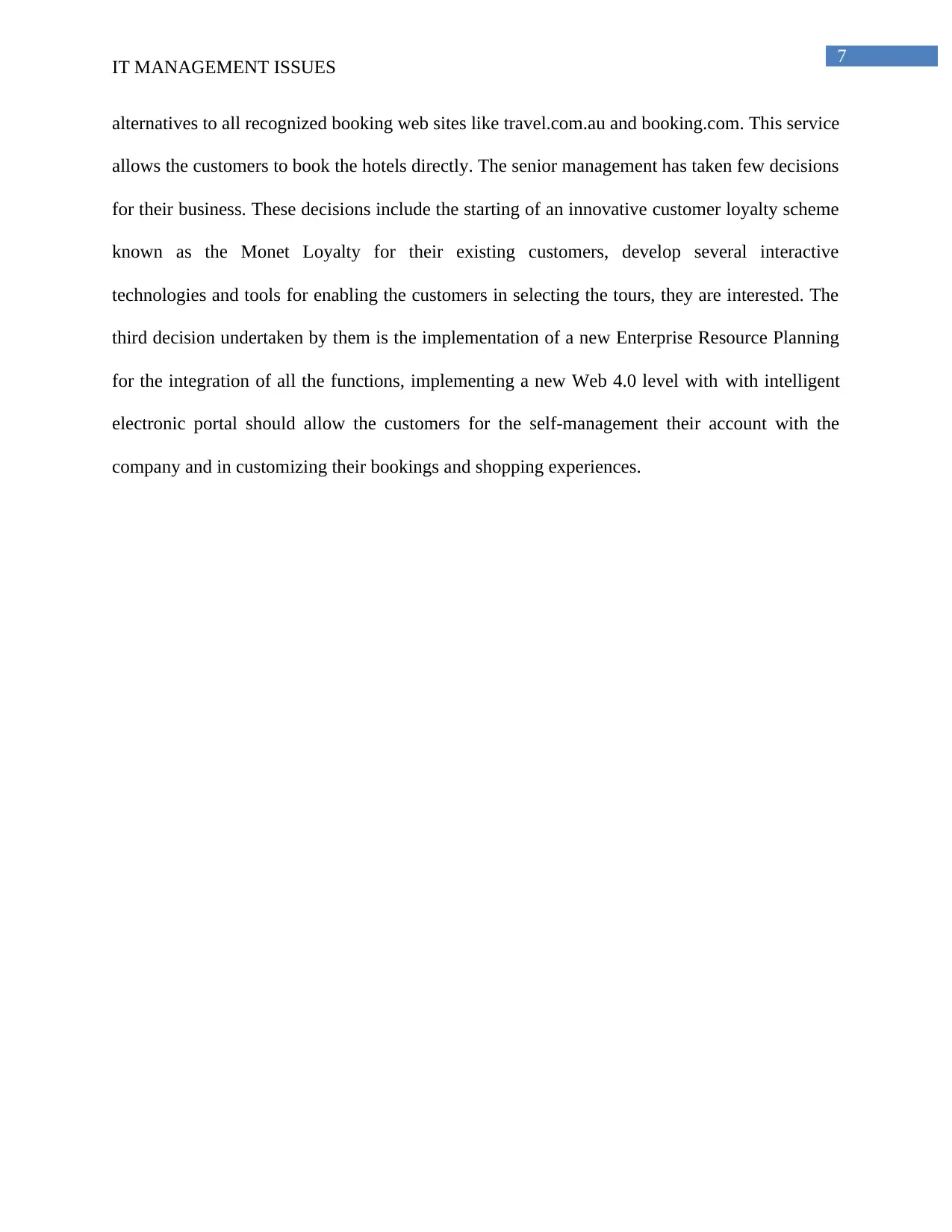
7
IT MANAGEMENT ISSUES
alternatives to all recognized booking web sites like travel.com.au and booking.com. This service
allows the customers to book the hotels directly. The senior management has taken few decisions
for their business. These decisions include the starting of an innovative customer loyalty scheme
known as the Monet Loyalty for their existing customers, develop several interactive
technologies and tools for enabling the customers in selecting the tours, they are interested. The
third decision undertaken by them is the implementation of a new Enterprise Resource Planning
for the integration of all the functions, implementing a new Web 4.0 level with with intelligent
electronic portal should allow the customers for the self-management their account with the
company and in customizing their bookings and shopping experiences.
IT MANAGEMENT ISSUES
alternatives to all recognized booking web sites like travel.com.au and booking.com. This service
allows the customers to book the hotels directly. The senior management has taken few decisions
for their business. These decisions include the starting of an innovative customer loyalty scheme
known as the Monet Loyalty for their existing customers, develop several interactive
technologies and tools for enabling the customers in selecting the tours, they are interested. The
third decision undertaken by them is the implementation of a new Enterprise Resource Planning
for the integration of all the functions, implementing a new Web 4.0 level with with intelligent
electronic portal should allow the customers for the self-management their account with the
company and in customizing their bookings and shopping experiences.
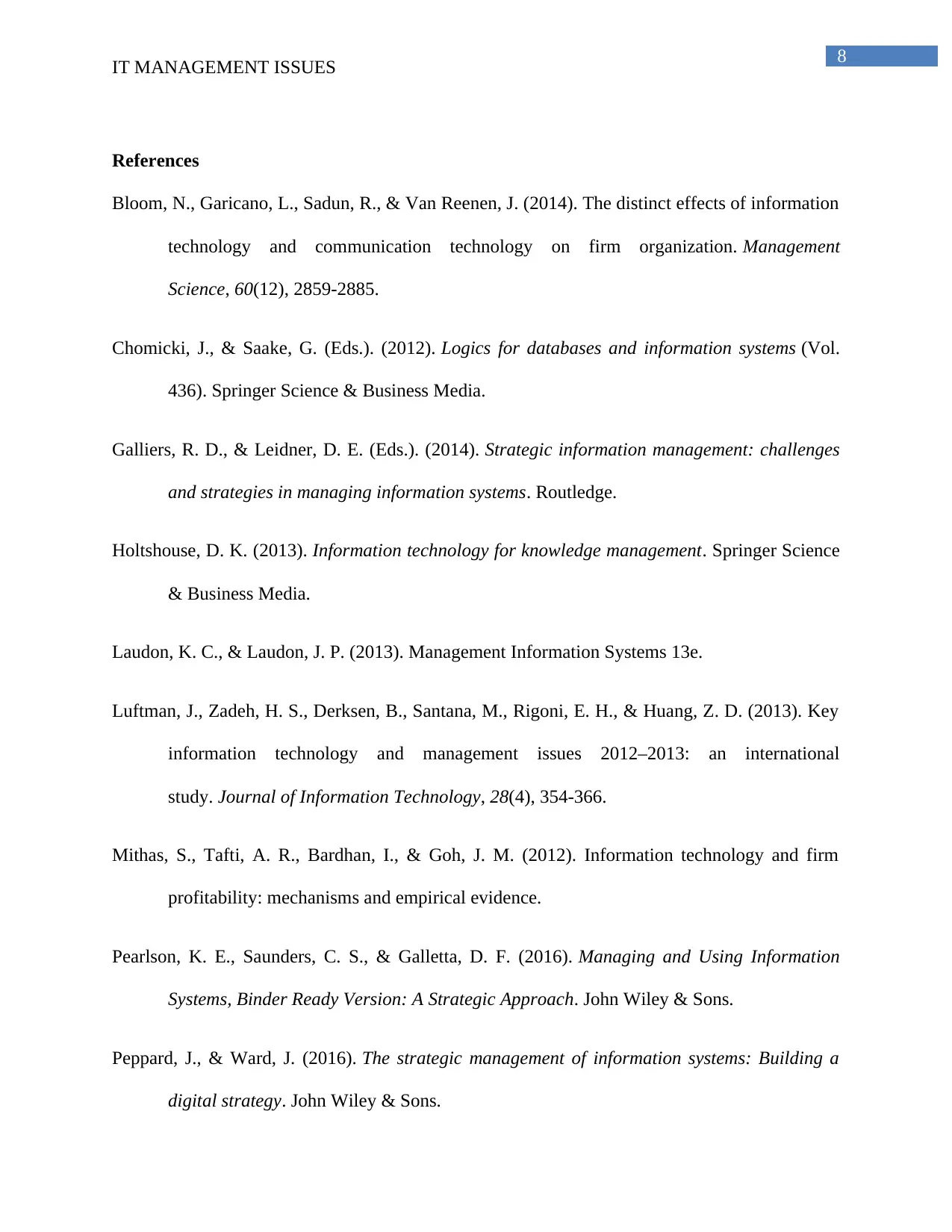
8
IT MANAGEMENT ISSUES
References
Bloom, N., Garicano, L., Sadun, R., & Van Reenen, J. (2014). The distinct effects of information
technology and communication technology on firm organization. Management
Science, 60(12), 2859-2885.
Chomicki, J., & Saake, G. (Eds.). (2012). Logics for databases and information systems (Vol.
436). Springer Science & Business Media.
Galliers, R. D., & Leidner, D. E. (Eds.). (2014). Strategic information management: challenges
and strategies in managing information systems. Routledge.
Holtshouse, D. K. (2013). Information technology for knowledge management. Springer Science
& Business Media.
Laudon, K. C., & Laudon, J. P. (2013). Management Information Systems 13e.
Luftman, J., Zadeh, H. S., Derksen, B., Santana, M., Rigoni, E. H., & Huang, Z. D. (2013). Key
information technology and management issues 2012–2013: an international
study. Journal of Information Technology, 28(4), 354-366.
Mithas, S., Tafti, A. R., Bardhan, I., & Goh, J. M. (2012). Information technology and firm
profitability: mechanisms and empirical evidence.
Pearlson, K. E., Saunders, C. S., & Galletta, D. F. (2016). Managing and Using Information
Systems, Binder Ready Version: A Strategic Approach. John Wiley & Sons.
Peppard, J., & Ward, J. (2016). The strategic management of information systems: Building a
digital strategy. John Wiley & Sons.
IT MANAGEMENT ISSUES
References
Bloom, N., Garicano, L., Sadun, R., & Van Reenen, J. (2014). The distinct effects of information
technology and communication technology on firm organization. Management
Science, 60(12), 2859-2885.
Chomicki, J., & Saake, G. (Eds.). (2012). Logics for databases and information systems (Vol.
436). Springer Science & Business Media.
Galliers, R. D., & Leidner, D. E. (Eds.). (2014). Strategic information management: challenges
and strategies in managing information systems. Routledge.
Holtshouse, D. K. (2013). Information technology for knowledge management. Springer Science
& Business Media.
Laudon, K. C., & Laudon, J. P. (2013). Management Information Systems 13e.
Luftman, J., Zadeh, H. S., Derksen, B., Santana, M., Rigoni, E. H., & Huang, Z. D. (2013). Key
information technology and management issues 2012–2013: an international
study. Journal of Information Technology, 28(4), 354-366.
Mithas, S., Tafti, A. R., Bardhan, I., & Goh, J. M. (2012). Information technology and firm
profitability: mechanisms and empirical evidence.
Pearlson, K. E., Saunders, C. S., & Galletta, D. F. (2016). Managing and Using Information
Systems, Binder Ready Version: A Strategic Approach. John Wiley & Sons.
Peppard, J., & Ward, J. (2016). The strategic management of information systems: Building a
digital strategy. John Wiley & Sons.
⊘ This is a preview!⊘
Do you want full access?
Subscribe today to unlock all pages.

Trusted by 1+ million students worldwide
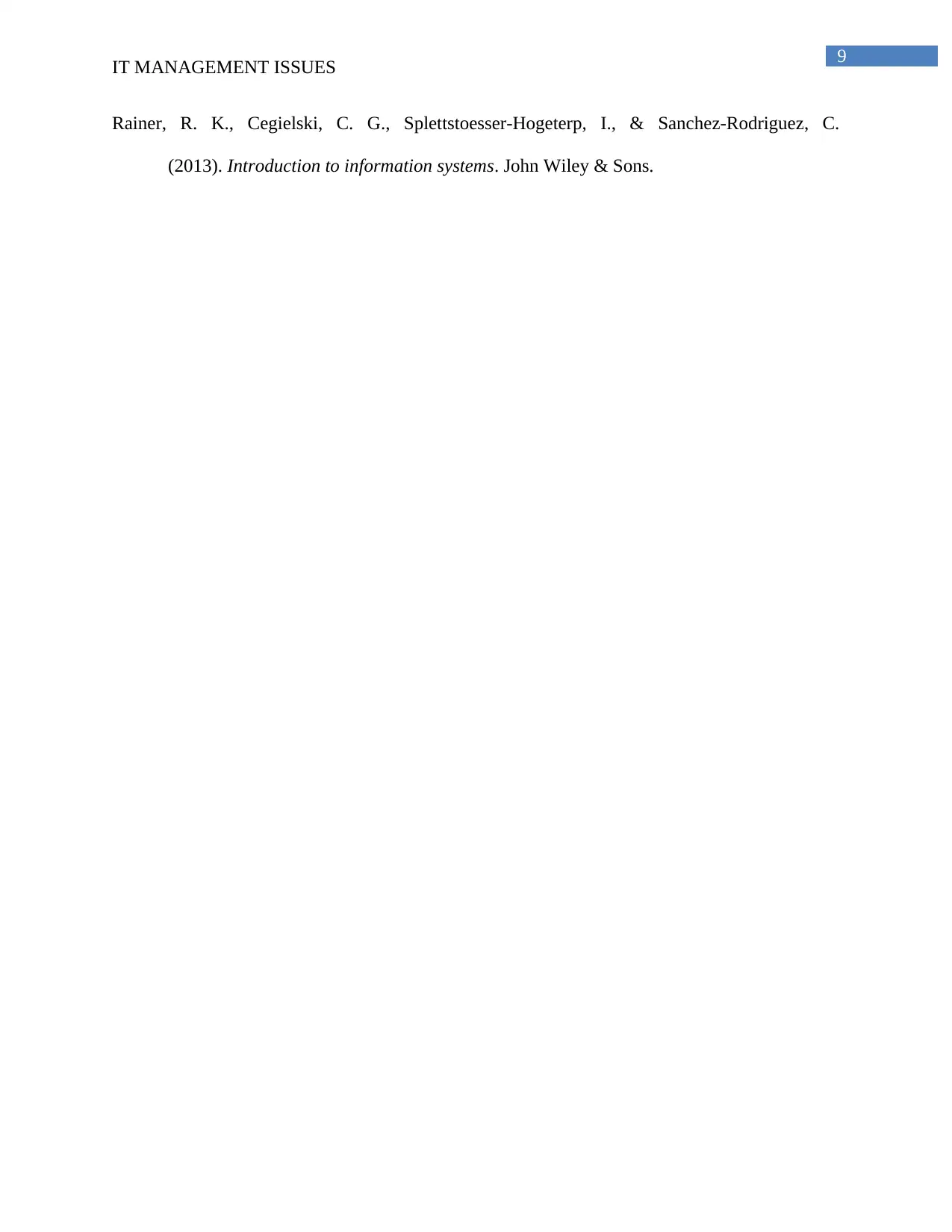
9
IT MANAGEMENT ISSUES
Rainer, R. K., Cegielski, C. G., Splettstoesser-Hogeterp, I., & Sanchez-Rodriguez, C.
(2013). Introduction to information systems. John Wiley & Sons.
IT MANAGEMENT ISSUES
Rainer, R. K., Cegielski, C. G., Splettstoesser-Hogeterp, I., & Sanchez-Rodriguez, C.
(2013). Introduction to information systems. John Wiley & Sons.
1 out of 10
Related Documents
Your All-in-One AI-Powered Toolkit for Academic Success.
+13062052269
info@desklib.com
Available 24*7 on WhatsApp / Email
![[object Object]](/_next/static/media/star-bottom.7253800d.svg)
Unlock your academic potential
Copyright © 2020–2025 A2Z Services. All Rights Reserved. Developed and managed by ZUCOL.





